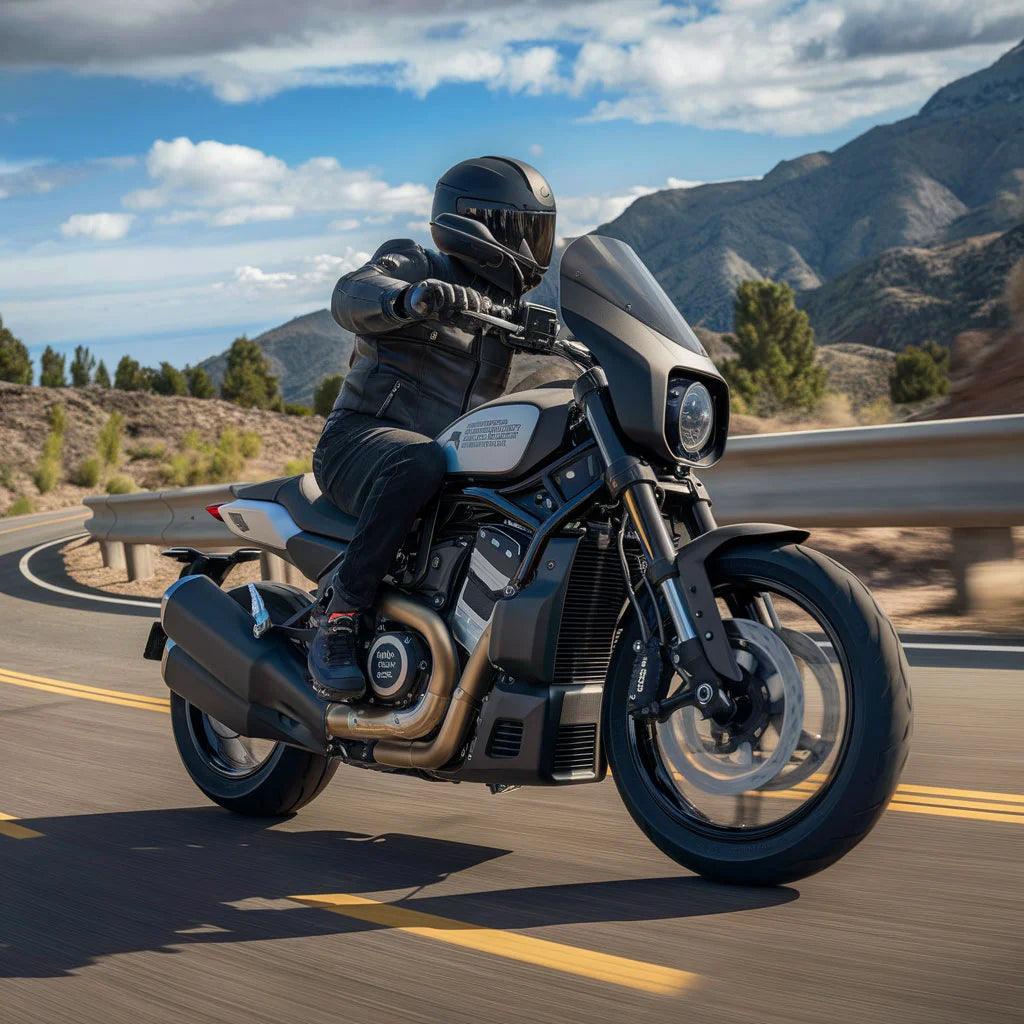RDRS Demystified: Understanding Harley-Davidson's Reflex Defensive Rider Systems

The Reflex Defensive Rider Systems (RDRS) from Harley-Davidson represent a major leap forward in motorcycle safety and performance.
As the most advanced technology package ever offered by Harley, RDRS aims to give riders more control and confidence on the road.
At its core, RDRS is comprised of a suite of rider aids and enhancements focused on braking, traction, and stability.
By leveraging advanced sensors and continuous Lean Angle Sensitive Systems, RDRS can optimize a motorcycle's handling and response in both upright riding and when leaned over in corners.
The main components of the RDRS system include:
- Advanced Antilock Braking System (ABS)
- Traction Control System (TCS)
- Vehicle Hold Control (VHC)
- Tire Pressure Monitoring System (TPMS)
- Drag Torque Slip Control (DSCS)
RDRS represents a commitment from Harley-Davidson to rider safety. While motorcycles will always carry more inherent risk than a car, RDRS aims to mitigate hazards and boost confidence for riders of all skill levels.
By combining multiple technologies, Harley has engineered an integrated safety system to watch over you on the road.
Advanced Braking Features
Harley-Davidson's Reflex Defensive Rider Systems (RDRS) offer riders advanced braking capabilities to enhance control and handling.
A key component is the Antilock Brake System (ABS), which helps prevent wheel lock-up during hard braking.
Sensors monitor wheel speed, and ABS modulates brake pressure to maintain traction. This allows the rider to brake hard while still steering the motorcycle.
Cornering Enhanced ABS (C-ABS) builds upon the ABS system by using additional sensors to account for motorcycle lean angle.
By factoring in lean angle, C-ABS can optimize brake force and distribution between the front and rear brakes when braking through turns. This improves stability when braking while leaned over in a corner.
The Electronic Linked Braking (ELB) system applies braking pressure to both front and rear brakes when the rear brake pedal is applied. This balanced braking enhances stability, prevents rear wheel lock-up, and helps shorten stopping distance.
For even more advanced stability, the Cornering Enhanced Electronic Linked Braking (C-ELB) system adds lean-sensitive control to the linked braking system.
C-ELB adjusts brake force distribution based on motorcycle lean angle to optimize braking when cornering.
Together, these advanced braking features give riders more control and confidence during braking, enhancing safety across different riding scenarios.
The cornering enhancements are especially key for maintaining stability and preventing loss of traction when braking in turns.

Traction Control Capabilities
The RDRS system offers advanced traction control features to help riders maintain stability and control in a variety of conditions (See Also: Parts of a Harley). Key components include:
Traction Control System (TCS)
The Traction Control System uses wheel speed sensors to detect and mitigate excessive rear wheel spin.
When TCS engages, it reduces engine torque to regain traction. This helps prevent the rear wheel from spinning and losing control. TCS is especially useful when accelerating on slippery surfaces.
Cornering Enhanced Traction Control System (C-TCS)
C-TCS builds upon standard TCS by using an inertial measurement unit to detect lean angle.
By understanding the bike's lean angle, C-TCS can optimize traction control for both straight line riding and cornering. This provides more precision traction management during turns.
Drag Torque Slip Control System (DSCS)
The Drag Torque Slip Control System helps maintain rear wheel traction when aggressively accelerating from a stop.
It prevents excessive engine torque from overpowering the rear tire during hard launches. DSCS works seamlessly with the transmission to meter power delivery.
Cornering Enhanced DSCS (C-DSCS)
Adding lean angle data gives DSCS the ability to fine tune hard launch traction control while leaned over in a corner.
C-DSCS works together with C-TCS to maximize acceleration traction in cornering situations. This results in improved launch performance and stability.
Additional Rider Assists
Harley-Davidson's RDRS system includes two key technologies to assist riders beyond braking and traction control: Vehicle Hold Control (VHC) and Tire Pressure Monitoring System (TPMS).
Vehicle Hold Control
Vehicle Hold Control (VHC) helps keep the motorcycle stationary when stopped on an incline. Without VHC, the rider would need to apply pressure on the rear brake to prevent the bike from rolling backwards on a hill.
VHC activates electronically to maintain the stopped position without any brake input from the rider. This allows the rider to focus on smoothly pulling away from the stopped position.
VHC is particularly useful when stopped on steep hills or in stop-and-go traffic situations. It provides added control and reduces rider fatigue from constantly applying the brakes.
The system works seamlessly, with no intervention needed from the rider. Once the throttle is applied, VHC will disengage and normal operation resumes.
Tire Pressure Monitoring System
The Tire Pressure Monitoring System (TPMS) on Harley-Davidson bikes with RDRS provides constant monitoring of tire pressures.
Sensors in the wheels measure pressure and temperature, communicating data to the motorcycle's instrumentation.
You May Also Like: Harley-Davidson Battery Size Chart
If tire pressure drops below optimum levels, the TPMS will alert the rider. Maintaining proper inflation is critical for motorcycle handling, braking performance, and preventing blowouts or other tire failures.
TPMS provides an important early warning system before pressures get dangerously low.
Riders can easily check tire pressures at a glance on the display screen.
TPMS reduces the need to manually inspect pressures before each ride. Keeping tires inflated to spec ensures maximum stability, grip, and braking capability - key factors enhanced by the RDRS system.
Cornering Enhancements
One of the most important advancements in the RDRS system is the addition of lean-sensitive technology to provide extra safety and control while cornering.
Cornering effectively on a motorcycle requires a delicate balance of braking, accelerating and leaning the bike. RDRS uses advanced sensors to detect the bike's lean angle and make automatic adjustments to optimize stability.
The cornering enhanced systems work by monitoring the bike's position and angle of lean as you navigate a turn.
When the bike is leaned over in a corner, the ABS and traction control make subtle changes to brake pressure and engine torque to keep the tires adhered to the road.
This prevents the loss of traction that can occur when braking or accelerating mid-corner.
The benefits of the cornering systems are immense for rider confidence and control.
By preventing skids and loss of traction, RDRS allows you to corner smoothly while maintaining maximum braking power.
The systems work in the background to expand the performance envelope so you can focus on the corner without worry. Riders report feeling significantly more confident leaning the bike over in turns with RDRS compared to riding without it.
The cornering enhancements make the bike feel planted and stable, increasing comfort and reducing anxiety when cornering in both wet and dry conditions.
Performance and Handling
The RDRS system has a significant impact on the overall performance and handling of Harley-Davidson motorcycles equipped with the technology.
Riders will immediately notice improvements in braking stability, traction control, and the general ride quality when riding with RDRS.
The advanced braking features like ABS and Linked Braking provide more consistent, balanced braking power.
The systems help prevent wheel lock-up and allow the rider to brake hard with confidence.
Braking distance is dramatically shortened, and the motorcycle's ability to decelerate rapidly in a straight line is enhanced.
You May Also Consider: What Makes a Harley Davidson Comfortable?
Traction control capabilities like TCS and DSCS help optimize rear wheel grip when accelerating on slippery or uneven surfaces. By mitigating excessive wheel spin, the motorcycle is able to put more power to the ground efficiently.
This results in improved acceleration, especially in low traction conditions. Less wheel slip means harder launches and more controlled throttle response.
Together, the refined braking and enhanced traction fundamentally transform the ride experience. The motorcycle handles curves, corners, and changing road conditions with poise.
By optimizing braking and acceleration forces, the RDRS system allows the rider to push the performance envelope with the confidence that the technology will help keep the motorcycle stable and under control.
The cornering enhancements take things even further by dynamically adjusting braking and traction based on the bike's lean angle. This enables aggressive corner carving while providing a reassuring safety net.
Overall, riding a Harley-Davidson with RDRS feels more precise, nimble, and responsive. The systems work imperceptibly in the background to elevate braking, acceleration, and handling to new levels.
Model Availability
Harley-Davidson offers the RDRS system as an option on many of its Touring, CVO, and Trike models. The specific RDRS features included depend on the model year and trim package selected.
The Touring models that can be equipped with RDRS include the Road Glide, Street Glide, Road King, Ultra Limited, and Electra Glide.
On Touring models, RDRS is included in the Reflex Defensive Package (RDP) option. This package contains linked ABS brakes, traction control, and other advanced rider aids.
For CVO models, including the CVO Limited and CVO Street Glide, RDRS comes standard. CVO bikes receive the full suite of RDRS technologies like cornering enhanced ABS and traction control.
Finally, RDRS is also available on Trike models like the Freewheeler and Road Glide Trike. The Trikes offer standard ABS brakes, with the option to upgrade to the RDRS package for extra safety enhancements.
When comparing models and trim levels, opting for a bike with the RDRS package provides the most complete set of rider aids.
While basic ABS is sufficient for many riders, choosing a CVO or a Touring model with the RDP upgrade will unlock the full potential of Harley's advanced safety systems.
Test riding different RDRS configurations is recommended to find the optimal setup for your riding style and needs.
Using the RDRS System
The RDRS system is designed to provide an optimal riding experience, but the rider has control over customizing and enabling different features. Here's an overview of using RDRS:
Enabling/Disabling RDRS Features
Riders can choose to independently enable or disable the ABS, TCS, VHC, and other systems via the settings menu on the bike's instrumentation display.
This allows you to customize RDRS based on riding conditions and personal preference. For example, you may want to disable TCS on a dirt or gravel road.
Rider Modes
Many new Harley-Davidson models with RDRS offer different rider modes that optimize the systems for different environments. Common modes include:
- Sport Mode: Reduced traction control and ABS intervention for a more aggressive riding experience.
- Road Mode: Balances performance, traction, and stability for ideal dry pavement riding.
- Rain Mode: Maximizes stability and traction control for slick surfaces.
- Eco Mode: Prioritizes fuel economy and smooth acceleration.
Note: While many models allow riders to switch between these modes on the fly via the bike’s instrumentation display, some models—such as the 2024 Road King—may have preset or automatically managed configurations. If the manual or website does not provide instructions for changing modes, it could be because the feature is not user-adjustable on that specific model. For detailed guidance, it is best to consult your local dealer.
Usage Tips
It takes time to get used to the enhanced control from RDRS. Here are some tips for utilizing the system:
- Start in Road or Rain mode to experience the full benefits of RDRS stability and traction.
- Slowly work up to more aggressive Sport mode as you get comfortable.
- On loose surfaces like gravel, consider disabling TCS and reducing ABS sensitivity.
- Take time to practice emergency braking maneuvers to experience the ABS in action.
- Lean into turns with confidence knowing the systems are optimized for cornering.
- Rely on RDRS but don't let it replace good riding skills and judgment.
Maintenance Tips
To keep the RDRS system running optimally, periodic maintenance and calibration is required. This ensures the various sensors and components are calibrated properly and operating within their specified parameters.
Sensor Calibration
The RDRS system relies on several sensors to provide input data, including wheel speed sensors, brake pressure sensors, accelerator position sensors, and more.
Over time these can fall out of their calibrated state due to vibration, contamination, or component wear.
Harley-Davidson recommends having your dealer check and recalibrate the RDRS sensors at least once per year or 12,000 miles. This sensor calibration is crucial to ensure the system is getting accurate data.
Warning Lights and Codes
If the RDRS system detects a fault, it will illuminate a warning light on the dash. Common warnings related to RDRS include ABS, TCS, TPMS, and brake system lights.
Diagnostic trouble codes can provide more details on the specific sensor or component that may need attention. Don't ignore RDRS warning lights - have your dealer check the system so problems don't escalate.
Service Requirements
The RDRS system has specific service requirements in the Harley-Davidson maintenance schedule.
This includes flushing and replacing brake fluid every 2 years to maintain proper ABS and linked brake performance.
Tires should be kept at correct pressures and tread depths. Software and diagnostic tools also need to stay up to date to service the latest RDRS components and calibrations.
Follow the manufacturer's recommendations to keep this critical safety system in top shape.
The Future of RDRS Technology
Harley-Davidson is continuously innovating and enhancing its Rider Safety Systems to provide an even higher level of performance, protection and peace of mind for riders.
With emerging technologies like advanced radar, lidar and machine vision systems, there is tremendous potential to take motorcycle safety to the next level.
RDRS has already come a long way from its initial introduction, with cornering enhancements and lean-sensitive capabilities representing a major leap forward.
Harley is likely to build on these successes by integrating more environmental detection, even higher precision braking and traction control, and active suspension systems that can dynamically optimize handling.
Some possibilities on the horizon include:
- More powerful onboard computers to rapidly process sensor data and enable quicker, more nuanced system reactions. This could allow for earlier hazard detection and smoother, less intrusive interventions.
- Integration of radar, cameras and other sensors to give the bike a fuller picture of the surroundings. This could enable collision avoidance features and semi-autonomous operation in certain situations.
- AI-powered systems that learn rider preferences and styles, customizing the RDRS to provide an optimal experience. The bike could even provide personalized coaching and feedback.
- Connectivity with other vehicles and infrastructure to expand the RDRS's awareness and capabilities. Bikes could coordinate maneuvers, get real-time hazard alerts, and more.
- Active aerodynamics that automatically adjust the bike's shape/profile based on speed, lean angle, wind conditions etc. This could enhance stability and control.
As computing power increases and costs decrease, we will see RDRS become more comprehensive, intelligent and natural feeling.
While maintaining the iconic Harley-Davidson riding experience, RDRS innovation will enable riders of all skill levels to enjoy the open road with greater thrill and less risk.
Harley's technology leadership in this arena is paving the way to the future of motorcycling.







For the 2024 Road King, the riding modes are preset and not adjustable by the rider, which is why you won’t find instructions in the manual or on the website.
No where in manual does it show how to change riding modes on 2024 road king and it does not mention it on there web site as a feature
What up with that
Leave a comment